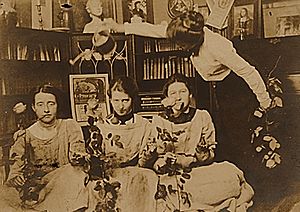The Plastic Club facts for kids

Plastic Club members in their early Chestnut Street studio, c. 1901
|
|
| Established | 1897 |
|---|---|
| Founder | Emily Sartain |
| Founded at | Philadelphia, Pennsylvania, U.S. |
| Purpose | arts organization for women to promote collaboration and members' works |
| Headquarters | 247 South Camac Street |
| Location | |
|
President (1897)
|
Blanche Dillaye |
The Plastic Club is an art group located in Philadelphia, Pennsylvania. It started in 1897 just for women. This makes it one of the oldest art clubs for women in the United States. The club is on Camac Street, which was known as the "Little Street of Clubs" in the early 1900s. Since 1991, men can also be members of the club.
Contents
The Plastic Club's Story
How the Club Began
The Plastic Club was started by Emily Sartain, an art teacher. It was created to help women artists work together and show their art. This happened partly because the Philadelphia Sketch Club was only for men. The first president of the club was Blanche Dillaye, who was an etcher.
Dillaye suggested the name "plastic." It means "the state of any unfinished work of art." The club's motto comes from a poem by Theophile Gautier:
All passes. Art alone
Enduring stays to us;
The Bust outlasts the throne,—
The Coin, Tiberius
The special symbol, or insignia, for The Plastic Club was designed by Elisabeth Hallowell Saunders.
Activities and Events
The club offered many things for its members. They could take art classes and attend social events. They also held art exhibitions to show off their work. A popular yearly event was their masquerade party, which they called "the Rabbit."
Famous Early Members
Many talented women artists were early members of the Plastic Club. Some of them included Elenore Plaisted Abbott, Cecilia Beaux, Fern Coppedge, and Violet Oakley. Many of these artists had learned from a famous teacher named Howard Pyle. In 1898, an art show featured works by Pyle's former students. These included Elizabeth Shippen Green, Jessie Willcox Smith, and Violet Oakley.
Helping the Community
In 1918, the club helped start the Philadelphia School of Occupational Therapy. This shows how art and crafts were connected to helping people recover from injuries or illnesses during that time.
Welcoming New Members
In 1991, the Plastic Club changed its rules to allow men to join. During the 1990s, the club also tried to get more art students involved. They offered free memberships to two new art school graduates each year.
The building where The Plastic Club is located, at 247 South Camac Street, became a historic landmark in Philadelphia in 1962.
Notable Past Members
The Plastic Club has had many important artists as members over the years. Here are some of them:
- Elenore Plaisted Abbott
- Paula Himmelsbach Balano
- Cecilia Beaux
- Mary Carnell
- Fern T. Coppedge
- Blanche Dillaye
- Grace Gebbie Wiederseim Drayton
- Katherine Levin Farrell
- Beatrice Fenton
- Beatrice Fox
- Elizabeth Shippen Green
- Violet Oakley
- Amy Otis
- Esther Richards
- Harriet Roosevelt Richards
- Harriet Sartain
- Emily Sartain
- Jessie Willcox Smith
- Wuanita Smith
- Alice Barber Stephens
- Alice Kent Stoddard
- Beatrice Pastorius Turner
- Sarah Stilwell Weber
- Mathilde Weil
See also
 In Spanish: The Plastic Club para niños
In Spanish: The Plastic Club para niños


